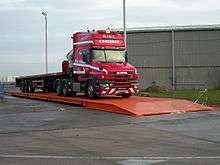Truck scale
A Truck scale (US), weighbridge (non-US) or railroad scale is a large set of scales, usually mounted permanently on a concrete foundation, that is used to weigh entire rail or road vehicles and their contents. By weighing the vehicle both empty and when loaded, the load carried by the vehicle can be calculated.
The key component that uses a weighbridge in order to make the weigh measurement is load cells.
Weight certification in the United States
Commercial scales have to be National Type Evaluation Program (NTEP) approved or certified. The certification is issued by the National Conference on Weights and Measures (NCWM), in accordance to the National Institute of Standards and Technology (NIST), "Handbook 44" specifications and tolerances,[1] through Conformity Assessment and the Verified Conformity Assessment Program (VCAP)[2]
Legal for trade
Handbook 44: General Code paragraph G-A.1.; and the NIST Handbook 130 (Uniform Weights and Measures Law; Section 1.13.) define Commercial Weighing and Measuring Equipment as follows;
weights and measures and weighing and measuring devices commercially used or employed in establishing the size, quantity, extent, area, or measurement of quantities, things, produce, or articles for distribution or consumption, purchased, offered, or submitted for sale, hire, or award, or in computing any basic charge or payment for services rendered on the basis of weight or measure.
NTEP approved scales are generally considered those scales which are intended by the manufacturer for use in commercial applications where products are sold by weight. NTEP Approved is also known as Legal for Trade or complies with Handbook 44. NTEP scales are commonly used for applications ranging from weighing coldcuts at the deli, to fruit at the roadside farm stand, shipping centers for determining shipping cost to weighing gold and silver and more.[3]
Types

- Electronic (deep pit type)
- Electronic (pit less type)
- Digital (deep pit type)
- Digital (shallow pit)
- Digital (pit less type)
- Rail Weighbridges
- Movable Weighbridge
- Mechanical weighbridge
- Mechanical (digital type)
- Electro-mechanical
- Portable weighbridge
- Axle scales
- Portable ramp end scales
Design Concept


Truck scales can be surface mounted with a ramp leading up a short distance and the weighing equipment underneath or they can be pit mounted with the weighing equipment and platform in a pit so that the weighing surface is level with the road. They are typically built from steel or concrete and by nature are extremely robust.
In earlier versions the bridge is installed over a rectangular pit that contains levers that ultimately connect to a balance mechanism. The most complex portion of this type is the arrangement of levers underneath the weighbridge since the response of the scale must be independent of the distribution of the load.[4] Modern devices use multiple load cells that connect to an electronic equipment to totalize the sensor inputs. In either type of semi-permanent scale the weight readings are typically recorded in a nearby hut or office.
Many weighbridges are now linked to a PC which runs truck scale software capable of printing tickets and providing reporting features.
Uses
Truck scales can be used for two main purposes:
- Selling or charging by weight over the bridge (Trade Approved)
- Check weighing both axle weights and gross vehicle weights. This helps to stop axle overloading and possible heavy fines.
They are used in industries that manufacture or move bulk items, such as in mines or quarries, garbage dumps / recycling centers, bulk liquid and powder movement, household goods, and electrical equipment. Since the weight of the vehicle carrying the goods is known (and can be ascertained quickly if it is not known by the simple expedient of weighing the empty vehicle) they are a quick and easy way to measure the flow of bulk goods in and out of different locations.
A single axle truck scale or axle weighing system can be used to check individual axle weights and gross vehicle weights to determine whether the vehicle is safe to travel on the public highway without being stopped and fined by the authorities for being overloaded. Similar to the full size truck scale these systems can be pit mounted with the weighing surface flush to the level of the roadway or surface mounted.
For many uses (such as at police over the road truck weigh stations or temporary road intercepts) weighbridges have been largely supplanted by simple and thin electronic weigh cells, over which a vehicle is slowly driven. A computer records the output of the cell and accumulates the total vehicle weight. By weighing the force of each axle it can be assured that the vehicle is within statutory limits, which typically will impose a total vehicle weight, a maximum weight within an axle span limit and an individual axle limit. The former two limits ensure the safety of bridges while the latter protects the road surface.
Portable versions
Portable truck scales can also be found in use around the world. A portable truck scale will have lower frame work that can be placed on non-typical surfaces such as dirt.[5] These scales retain the same level of accuracy as a pit-type scale, with accuracy of up to + or - 1%.[6] The first portable truck scale record in the US was units operated by the Weight Patrol of the Los Angeles Motor Patrol in 1929. Four such weighing units were used with one under each of the trucks wheels. Each unit could record up to 15,000 pounds (6,800 kg).[7]
See also
References
| Wikimedia Commons has media related to Weighbridges. |
- ↑ NTEP- Retrieved 2011-09-17
- ↑ Conformity-assessment- Retrieved 2011-09-17
- ↑ http://ntep.balances.com/and/legalfortrade.html
- ↑ "How a Truck Scale Works." Popular Science, June 1960, pp. 78-79, early design concepts behind weightbridge scales
- ↑ "How to Buy a Truck Scale".
- ↑ "Truck Scales".
- ↑ "Portable Scales Detect Overweight Trucks." Popular Science Monthly, November 1929, p. 62, bottom of page.